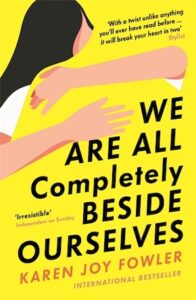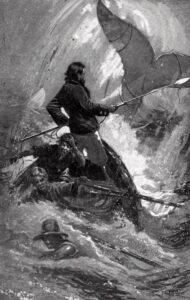Queer families
by Beatrice Hitchman
“A gorgeous trip across time and identity, through war and fascism, to show how people make new families and find ways to love each other.” Kate Pullinger
Is blood thicker than water? Or is family chosen, acquired throughout our lives? Ask me in the immediate aftermath of a family Christmas, and I’ll say definitely, definitely it’s not about genetics – no ties but what we make! But sit me down with my sister in the peace of her kitchen for a cup of tea, and I’ll tell you how uncanny and reassuring it is to see the tilt of her chin looking just like mine.
Such questions are the subject of my latest novel, All of You Every Single One. Our central couple, Julia and Eve, have to confront what makes a family – first when they run away together to Vienna in 1911, leaving all ties behind, and again because of Julia’s longing for a child – something that is hard to achieve through the usual routes. There’s also politics to contend with – as well as being a queer couple, they’re living in the Jewish quarter of 1910s Vienna, a melting pot and an exciting city, but rife with antisemitism and nascent right-wing movements.
Luckily for me, I had some literary models to help me think through what a queer family might look like. Here, I present a Top Ten Queer Families in Literature. I’ve cast a wide net, taking queer in its broadest theoretical definition of non-heteronormative, not-fitting-the-model. Partly, this is because there just aren’t that many gay parents in literature (yet, that I know of). A pity, some might say, but also, I’d argue, an opportunity. What might a family look like if it could be anything?
The Madrigal clan (Tales of the City)
Armistead Maupin was the first to popularise the term logical family (as opposed to biological), and to bring the term to prominence in his Tales of the City novels. Here, a young gay man arrives in San Francisco, leaving his conservative parents behind. He quickly falls in with a group of intimate friends – the denizens of Barbary Lane – who become like family to him in the new, exciting city. Touchingly, Maupin follows the same set of characters all the way through the 70s, 80s and into the 2010s – a real portrait of found family across the ages, showing that chosen bonds can be as strong as accidents of genetics.
The von Trapps (The Sound of Music)
You know what – I am conflating camp with queer here, but who cares? If any musical has spawned a sing-a-long-a version with bonus nuns, I think we can claim it for the community as one of our favourite things. The adorable, Russian-doll von Trapps are a parody of a heteronormative family unit… or, perhaps, the family many non-heterosexuals dream of: a loving home in which eccentricities are tolerated – nay, celebrated; in which mountains get climbed, kittens get whiskered, and in which it’s fine for the Captain to shock the bourgeoisie and marry for love, not status.
It’s interesting that there are so few representations of gay parenting in mainstream literature, and perhaps no accident that those we do find are expressed in the Gothic.”
The Lestat-de Pointe du Lacs (Interview with the Vampire)
Just when you think Anne Rice’s vampire classic can’t get any more gay and transgressive, Lestat and Louis, our heroes, decide to expand their family and adopt/make a vamp-baby: the doll-like, murderous Claudia. The three live in a version of a happy, homicidal family unit, although it’s no surprise that Claudia’s adolescence is a little challenging. It’s interesting that there are so few representations of gay parenting in mainstream literature, and perhaps no accident that those we do find are expressed in the Gothic – long the genre where outlandish ideas ahead of their time come out to play.
 The Cookes (We Are All Completely Beside Ourselves)
The Cookes (We Are All Completely Beside Ourselves)
Impossible to say much about this fantastically curious family without spoilers. We can only say that Karen Joy Fowler’s book stretches our definition of what a sibling could, or should be. Tender and profound, it introduces the idea that we might all be, in some way, adjacent to our own selves when it comes to family attachments – in a continual process of trying to figure out whom we love and why – and that maybe that’s no bad thing.
The Bechdels (Fun Home)
Before she was known for the Bechdel Test, Alison Bechdel made her name writing graphic novels, including the extraordinary graphic memoir Fun Home. She writes about growing up in a very queer setting: not only odd because her father is a funeral director, but also because, as she starts to realise, he, like her, is same-sex attracted, despite being married to her mother and having two kids. She likens the emotionally fraught home to the Labyrinth, and her father to the Minotaur, but for the reader, it’s a devastating, illuminating maze to get lost in.
The Justineaus (The Girl with All the Gifts)
Gothic horror delivers another zinger with M.R. Carey’s clever, deft tale of a schoolteacher who ends up adopting a young half-zombie… and then a whole lot more. Helen Justineau has one job – to try to ‘humanise’ a class of children who are anything but – in a prison camp at the end of the world. The relationship between Helen and Melanie is complicated, touching and provocative, and what better place to test the bonds of found family than fleeing across a post-apocalyptic Britain?
I think there’s another reading, about this fatally Oedipal band of brothers – the crew of the Pequod – all of whom are escaping their unitary families to head to sea.”
The Ahabs (Moby-Dick)
Then there you lie, like the one warm spark in the heart of an arctic crystal… Lots has been written about the queer masculinities of Moby-Dick: Ishmael’s attraction to Queequeg, or Ahab’s relentless pursuit of the sperm whale. But I think there’s another reading, about this fatally Oedipal band of brothers – the crew of the Pequod – all of whom are escaping their unitary families to head to sea; the whale, and maybe even the sea itself, become part of their tribe.
The Bauers (Fragment of an Analysis of a Case of Hysteria)
In 1900 a young woman, Ida Bauer, came to Sigmund Freud wanting a cure for nervous problems. Freud quickly unearthed quite the family dynamic. Buckle up, because this gets complicated: Ida Bauer’s father may have been having an affair with a family friend’s wife, Frau K; said friend, Herr K, had made advances on Ida, which distressed her because she was really more interested in the wife herself. Despite the clear indication of queerness, Freud ignored Ida’s sexual leanings, and decided that she was probably repressing an attraction to Herr K. The analysis did not go well, but it was fertile ground for the characters in my book, which explores this case study in more detail.
House Ferocity (Pose)
Impossible not to include this – admittedly – TV series, as one of the groundbreaking representations of queer family of our time. Pose brings New York 80s ballroom culture to a mass audience; a world in which drag queens and transgender stars form their own ‘houses’ or families and compete to be the most fabulous. In the series, you’re meant to root for House Evangelista, led by plucky Blanca – but I’ve got a soft spot for House Ferocity, in particular the gloriously dysfunctional Candy. Her standout episode (S2, E4) is a defiant, sequinned, elegiac and magical landmark moment in queer TV.
The Walter-Ironson-Belize-Pitt-Angels (Angels in America)
There’s a striking scene at the start of Tony Kushner’s Angels in America. We are in 80s New York; closeted, anxious Louis Ironson attends the funeral of his grandmother. Louis’ lover, Prior, has AIDS, and Louis isn’t sure he can cope with being his carer any longer. He asks the rabbi what happens to people who walk out on their loved ones in their direst times, and the rabbi looks at him blankly: Why would a person do such a thing? This is only the beginning of Kushner’s devastating and moving play sequence, which demands to be read, or viewed, in full; but it’s a moment that’s stayed with me, as it seems to be at the heart of what family is all about, wherever you find it.
 Beatrice Hitchman is an author and academic. Her first novel Petite Mort (Serpent’s Tail, 2013) was nominated for the Desmond Elliott Prize, the Polari Prize, the HWA Debut Prize and the Authors’ Club Best First Novel Prize. It was also adapted into a ten-part Woman’s Hour drama on BBC Radio 4. Born in London in 1980, she has lived in Hong Kong, Edinburgh and Paris, and currently works as a Senior Lecturer in Creative Writing at the University of Gloucestershire. All of You Every Single One is pubished by Serpent’s Tail in hardback and eBook.
Beatrice Hitchman is an author and academic. Her first novel Petite Mort (Serpent’s Tail, 2013) was nominated for the Desmond Elliott Prize, the Polari Prize, the HWA Debut Prize and the Authors’ Club Best First Novel Prize. It was also adapted into a ten-part Woman’s Hour drama on BBC Radio 4. Born in London in 1980, she has lived in Hong Kong, Edinburgh and Paris, and currently works as a Senior Lecturer in Creative Writing at the University of Gloucestershire. All of You Every Single One is pubished by Serpent’s Tail in hardback and eBook.
Read more
beatricehitchman.com
@hitchmanbea
@serpentstail
Author portrait © Sarah Lee


